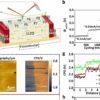Researchers from Hanyang University and Inha University have introduced collective behavior of multiple swimming robots for delivery of thousands of cargos.
Although a single cargo can be transported by delicate grasping and releasing motions of a single gripping device, gripping devices themselves have presented difficulties in transporting a large number of cargos rapidly and simultaneously. It is time-consuming to grip, transport, and release cargos one-by-one. Led by Jeong Jae Wie, Associate Professor at the Department of Organic and Nano Engineering in Hanyang University, researchers addressed this issue through a vortex-induced transportation strategy using multiple robotic actuations.
In the study, published in Nature Communications, the research team worked with a collection of > 4,000 floating microplastics. “When multiple robots swam above-water with agile rotational swimming motions, they could generate a vortex, and thousands of floating microplastics could become trapped in the vortex,” said Sukyoung Won, a doctoral candidate at Inha University, who is co-advised by Wie at Hanyang University and is the first author of the paper.
“The trapped microplastics were transported and collected by moving multiple swimming robots. In addition to floating microplastics, heavy semi-submerged millimeter-scale cargos could be located in a target area through the vortex-induced transportation strategy.”
Before delivering thousands of floating microbeads into a partitioned space, the research team was able to block microbeads from entering inward by switching the actuation mode of the robots from rotational swimming to rectilinear translational swimming. “Due to the agile swimming speed of the swimming robots (up to 180 body lengths per second), the floating microbeads could be blocked or confined in the partitioned space,” said Won.
“For agile above-water swimming capability, we designed nanocomposite robots, inspired by the musculoskeletal system. Spongy bone and skeletal muscle components were emulated using a lightweight yet stiff carbon nanotube yarn surrounded with a magnetic polymer composite.”
“This cargo transportation by multiple swimming robots shows the importance of collective behavior which is hard to accomplish with a single robot,” Professor Wie added. “The multimodal collective swimming of biomimetic robots can pave the way for robot designs and actuation strategies of swarming robots for enabling microplastic removal, cargo delivery, and microfluidic vortex control.”
More information:
Sukyoung Won et al, Multimodal collective swimming of magnetically articulated modular nanocomposite robots, Nature Communications (2022). DOI: 10.1038/s41467-022-34430-2
Provided by
Hanyang University
Citation:
Multiple swimming robots able to create a vortex for transportation of microplastics (2022, November 21)



